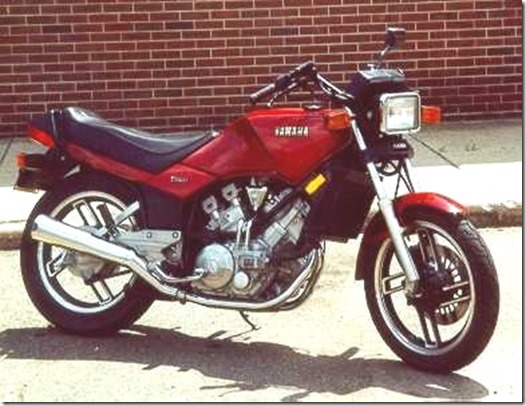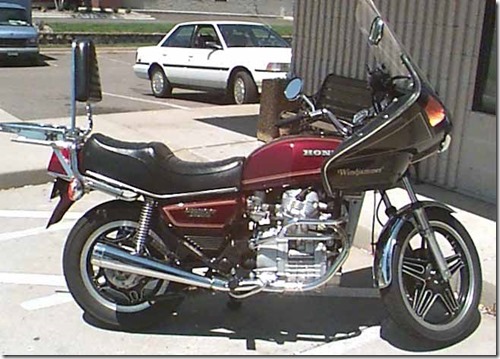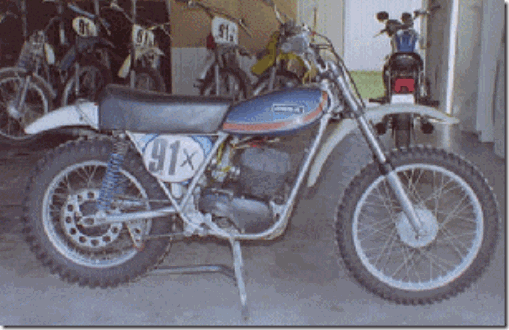And Now for Something Really
Different
All Rights Reserved © 2001 Thomas W. Day
An absolutely valid rap
"against" the bikes I usually ride is that nobody ever looks at my ride and I
rarely hear "wow! what a cool looking bike." If that bothered me, the Pure
Polaris Electric Scooter would be the cure. Polaris claims that this snazzy
little unit will do up to 12 miles at speeds of 16-18mph. I'll test that claim,
later, by making the poor little Scooter lug my 200+ pound butt around town and
country.
Early on, I thought I'd never
find out what the average speed is over any distance beyond a couple hundred
yards. Take my first morning out, for example. I made it two blocks when a
semi driver passed me and stopped in the middle of the road so he could ask me
how the Polaris was powered (electric motor) and what it's range was (how the
hell would I know?) and what it weighed (59 pounds, without me). Two blocks
later, I almost passed two power-walking women before getting stopped to answer
the same questions plus "where can we buy one? (see your nearest Polaris dealer
or call the company in Medina). Three blocks later, a guy in a Buick stopped me
to ask about the range, the manufacturer, the cost, and to tell me he thought it
would be a great vehicle to ride to his deer stand. At the coffee shop, three
blocks later, in a half hour I got to read two pages of my book while answering
questions about the scooter from half of the people in the store. The ride home
was just as talkative. A little more than six blocks, four stops, four
conversations, and I should be getting a free Electric Scooter t-shirt from
Polaris so that I can complete my rolling advertising campaign for the Electric
Scooter.
Since you mostly know me as the
Geezer and you know how naturally crotchety I am, here's where you should be
expecting my long list of gripes on the Scooter. I'd like to accommodate you,
but so far I'm having too much fun with the damn thing. So is my wife, and I
guess I could complain about that. When she's riding it, I'm not. She's
already imagining a business where she rents these things to companies for
parades, as sort of a rolling signboard. I suppose she'll expect me to wear a
Shriner outfit and ride the Scooter to get the company . . . rolling. I may not
care about looking cool, but I'm definitely opposed to looking dorky. Believe
it or not, I have standards, they're just lower than average.
I first saw the Electric
Scooter at a MN-Sportbike pre-event. One of the sportbikers brought his Scooter
along to get from one end of the track to the other without having to mess up
his Nike's. He offered a ride to anyone who wanted to play with it, but I was
the only taker. Now I know why. Ride it and you gotta have one.
He had pulled the seat off of
his Scooter and was riding it skateboard style. I, mostly, ride mine the same
way. My wife likes the seat. I just feel slightly less like I'm posing as an
invalid on a powered shopping cart when I'm standing. (See what I mean about
having standards?) The seat is way too comfortable and it doesn't allow for
drastic weight-shifting which makes getting over curb entrances, at top speed, a
lot more interesting.
The Polaris Scooter is
suspended. The suspension is slightly more elaborate than the typical kick
scooter, but it's good enough to suck up sidewalk irregularities and sloped curb
entrances. I've been told that the Scooter works fairly well on dirt roads,
too. I haven't tried mine because I'm nearly over the weight limit just by
wearing shoes. Adding the resistance of dirt roads would probably trip the
circuit breaker in a few minutes.
The Scooter's brakes are more
than adequate, a mountain bike V-brake on the front and a drum brake on the
rear. The rear brake is also connected to the engine cutoff, so you can't brake
and throttle at the same time. Sort of an idiot switch, I guess. The controls
are in a motorcycle layout, right side = front brake and left side = rear brake,
so you won't have to waste time re-routing cables like you did with your
mountain bike.
Most of the Scooter's weight
must be in the tires, batteries (and their bash-rail-protected steel case), and
motor, since the frame is aluminum as are most of the other metal bits. The
unit folds into something that could be carried on to a bus or packed in the
trunk of a Geo. The seat and handle bar height are fully adjustable and the
hardware is all high quality bicycle bits. The throttle/battery capacity
indicator is a thumb control dead-man switch control by the right-side grip.
bar height are fully adjustable and the
hardware is all high quality bicycle bits. The throttle/battery capacity
indicator is a thumb control dead-man switch control by the right-side grip.
The battery easily charges
overnight from near-dead and the manual claims that the battery will charge from
70% depleted to full in 6 hours. The charger is a high-tech, light-weight unit
that fits in a hiker's tailbag so you can carry it with you on longer trips
(using your employer's AC to provide energy for the return trip, for example).
The connector is an XLR (standard audio connector) which is unusually durable
and reliable for this purpose. The connector on the battery-end of the charging
connection has a cover which will provide a little protection from dirt but it's
far from water-tight.
The owner's manual contains a
bit of age discrimination, since Polaris states the bike is for "age 12 to 45"
riders. If I weren't old I wouldn't be the Geezer and I resent being told that
I'm too ancient to play with a toy that is this much fun. Repeal that
limitation, Polaris Marketing/Legal department. I'd sue, but I'll probably fall
down and bust my hip between now and when I'd get to court and Polaris would get
to use me for evidence that the manual's precautions are justified.
The other precaution that seems
a little paranoid is their warning against riding the Scooter downhill. Unless
you are a Flat Earth'er, it's hard to imagine a place you can ride where you're
not either going uphill or downhill. I see two possibilities regarding this
contraindication: 1) it's a legal butt-covering tactic, 2) downhill operation
could over-charge the battery. In Amerika it's always reasonable to assume that
any idiot who finds a way to go over the bars and bust his empty skull will
immediately locate a lawyer and claim "manufacturer negligence." However, I'd
appreciate knowing if this warning is legal gibberish or some sort of limit on
the Scooter's capability. I've noticed that even when the battery is off and
the handlebar kill switch is off, the charge-condition LEDs light up when the
bike is pushed. If the battery is getting a recharge from the motor during
downhill operation, that recharge might be unregulated and could damage the
battery or other circuitry. I'll wait by the phone for a response to this
question. I'm reasonably patient about these things. Ten minutes and no one
has called, I give up. I'll keep riding it up and down hills and I'll let you
know how that works out for me.
Polaris is, apparently, a
little confused about how they want to support the Electric Scooter. Their
marketing handout and the Pure Polaris website (http://www.purepolaris.com/)
states that the unit comes with "a year limited warranty." The owner's manual
revises this number to 90 days. I'm guessing the warranty is somewhere between
90 and 365 days (note: Polaris confirmed the one year limited warranty).
In the end, the company simply pretended the scooter never existed and, to this
day, their misnamed "Customer Service" department pantomimes shuffling through
pages of manuals and computer screens before saying "We never sold an electric
scooter."
Riding the Scooter is about as
simple as two-wheeled riding gets. The electric motor provides bags of torque.
When the battery is freshly charged it's not that difficult to life the front
wheel on full power takeoffs. You simply press the thumb control and go. The
Scooter is up to max speed about the time your foot hits the floorboard. The
belt-driven, 350W rare-earth magnet motor is quiet and amazingly powerful for
its size.
The 12" wheels roll over minor
road irregularities and the suspension sucks up the rest. The bike moves fast
enough that you'll need to use countersteering techniques to turn quickly.
Standing or seated, the Scooter is agile and responsive, although you do have to
get used to applying power a few seconds before you want it, because of the
time-delay between the thumb control and a reaction from the motor.
So far, I've learned these
simple rules for my Scooter: 1) turn the freakin' battery switch off if you want
the charger to do its job, 2) watch the weather, unless you want to walk home in
the rain (electric motors and rain don't mix), 3) try to avoid police attention
because nobody is sure how the law applies to this sort of vehicle, 4) use lots
of body english to take advantage of the limited-travel suspension. I've made
three 10 mile, round-trip excursions on my Scooter and have returned with power
to spare. I'm about to test the unit on a home-to-work commute, but I'm
building up to it since I haven't found an efficient, limited-traffic route as
yet. My bicycle has wasted away (while my belly is doing quite well, thanks for
asking) because the Scooter is a lot more fun than the bike. Any trip from
home, shorter than ten miles, gets made on the Scooter. It's more fun than the
bike, more efficient than either the car or the motorcycle, and I'm starting to
enjoy the attention.
I always assumed I'd give this
to my grandson when he turned 13 and was old enough to ride it on the street
legally. However, he snapped off the throttle lever practicing wheelies and
snuck the scooter back into the garage without telling me about the damage or
saving the broken part. Now, Polaris is doing
a wonderful Sergeant Schultz imitation ("I know nothing.") and Wolfegang's
window of opportunity and interest has past. Most parts that matter, like battery replacements are easily available on Amazon and through other on-line vendors.
2010 Postscript: Polaris has continued to disavow any
knowledge of this vehicle since around 2004. Because of this review, I get emails from
all of the company's victims/customers wanting to know where to buy parts for
this little scooter. Through direct conversation with the company, I have been
told "we never made/sold anything like that." They are, obviously, either liars
or fools. This was a high-end attempt to get into the electric runabout business
(at $1,000 MSRP) and Polaris isn't fooling anyone by pretending to be ignorant.
They were probably too late to the market with too little support and their
usual marketing stupidity and decided to cut and run from the model without a
thought in their tiny little marketing/sales heads about the customers they were
abandoning. Sorry, guys. I can't help you fix your electric scooter and I can't
find parts for my own. I desperately need a new throttle mechanism, but I'm out
of luck and the scooter is stuck in my shop until I find a substitute or give up
and toss it in the dumpster.
2014 Postscript: Holy crap! I found a live person
in Polaris' customer service and received this response:
Thank you for contacting Polaris. I apologize
that you have had a poor experience with service parts for your electric
scooter. Your model is called the EV Rider Xport SLX 707. This is a scooter with
front and rear suspension and has the narrow tires. These scooters were made in
the mid 2000’s and Polaris does not support these vehicles internally; however,
service parts are available for the Polaris Electric Scooter directly from
“Light Electric Vehicle Technologies.” They can be contacted at 1-888-743-3738
or levtservice@aol.com. [Talk to Shelly.]
Thank you for your inquiry,
Kyle
Parts Resolution Specialist
Polaris Industries
1-800-POLARIS
I don't know about the rest of Polaris Industries "Parts Resolution
Specialists," but Kyle kicks ass. It took about a week and $24 (including
shipping) for the throttle lever to arrive, a minute to install it, and our
Polaris Electric Scooter/EV Rider Xport SLX 707 is back on the road. Many of the
other parts for this scooter are common, like the batteries and drive belt, and
the less common stuff may be in stock with Light Electric Vehicle Technologies (602 S 1st Ave, Pocatello, ID 83201 208-232-5515).
2020 Postscript: This August, I decided I had too many electric bikes (and one scooter) in my garage. I put the Polaris scooter up on Craig's List and was swamped with emails and calls. A local guy bought it as a reward for his daughter's excellent academic performance and, last I heard, she was lovin' it. I hadn't fired it up for a couple of years when I made the decision to clean out the garage. It needed one new battery, some connector cleaning, a little cosmetic work, air in the tires, and it was good to go. I even took it for a ride with my GPS in hand to verify the scooter's top speed (14mph) for the Craig's List ad. I have some really good memories of this scooter, but I have moved on to eBikes.
 The Yamaha Vision was a great bike, for me. The picture above isn't really of the bike I owned. I snagged this picture from the Yamaha Vision Users webpage, because I never, ever, took a picture of my own '82 Vision. I can't explain why. (There's no accounting for when and why I might use a camera, because I really disliked taking pictures at almost any time. In the digital world, that's changed, but the hassle of carefully handling film and delivering it to a store for developing just didn't interest me.) My own '82 Vision had a Rifle fairing, which made the bike extremely comfortable and provided decent protection from rain and weather. Otherwise, it looked exactly like this bike. Bone stock. The only other modification I made to my '82 was a tapered headstock bearing to calm the bike's tendency to shake at higher speeds.
The Yamaha Vision was a great bike, for me. The picture above isn't really of the bike I owned. I snagged this picture from the Yamaha Vision Users webpage, because I never, ever, took a picture of my own '82 Vision. I can't explain why. (There's no accounting for when and why I might use a camera, because I really disliked taking pictures at almost any time. In the digital world, that's changed, but the hassle of carefully handling film and delivering it to a store for developing just didn't interest me.) My own '82 Vision had a Rifle fairing, which made the bike extremely comfortable and provided decent protection from rain and weather. Otherwise, it looked exactly like this bike. Bone stock. The only other modification I made to my '82 was a tapered headstock bearing to calm the bike's tendency to shake at higher speeds.




 bar height are fully adjustable and the
hardware is all high quality bicycle bits. The throttle/battery capacity
indicator is a thumb control dead-man switch control by the right-side grip.
bar height are fully adjustable and the
hardware is all high quality bicycle bits. The throttle/battery capacity
indicator is a thumb control dead-man switch control by the right-side grip.



